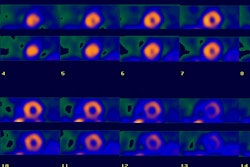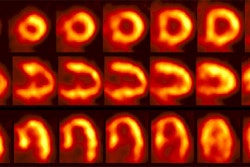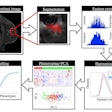Blood Volume Determination
Using isotope dilution methods, plasma and red cell volume determinations may be made. The most common clinical application of this test is when evaluating patients for polycythemia vera. Plasma volume determinations may be useful in select patients when more standard methods of estimating volume status are difficult, such as in burn patients. Other uses include evaluation of SIADH and primary hyperaldosteronism.
Physiology
By diluting a known activity and volume of radiotracer in an unknown volume and then measuring the activity in a volume withdrawn after adequate mixing, one can determine the unknown volume. This relationship can be expressed by the following formula:
V1 * C1 = V2 * C2; therefore V2= V1* C1/ C2
where
V2= unknown volume
V1 = volume of tracer injected
C1 = Concentration of injected isotope (counts/min/ml)
C2= Concentration of sample obtained after adequate mixing (counts/min/ml)
For this technique to give accurate results several assumptions must be met:
(Diagnostic Nuclear Medicine. Third Edition, Vol 2.)
- The tracer localizes only to the compartment being studied (e.g. vascular system). This is rarely the case. However, if equilibrium is reached rapidly enough, before a significant amount of tracer leaves the compartment being studied, accurate results can be obtained. Using labeled albumin, approximately 1% of the label is lost outside the vascular space per 10-15min.
- The tracer is not metabolized or synthesized within the body as this would falsely elevate and reduce the volume determined. If the tracer is excreted during the study, this must be accounted for (e.g. urine excretion).
- The volume to be measured does not change significantly during the study. This is usually not a problem; however, intravenous infusions and blood transfusions during the course of the study could affect results. Patient positioning can also cause expansion or contraction of the vascular system, therefore, samples should be taken with the patient in the same position each time.
- The radiotracer must be stable, and in a small enough volume as to not affect the volume being measured.
- Activity of doses and samples must be easily measurable.
- Equilibrium must be reached before samples are drawn. At our institution a 20minute sample is used, however, it should be noted that the rate of mixing can vary from patient to patient especially in conditions such as shock or very elevated hematocrits in which mixing may be delayed considerably.
Plasma Volume
Technique
For plasma volume determination, I-125 RISA is used (T1/2=60.2days, gamma [6.6%]=35.5KeV, characteristic x-ray [76%]=27KeV).
- A standard is prepared by adding one dose syringe of I-125 RISA into 1000cc of saline solution. Mix thoroughly and pipette 3cc into a counting vial. At our institution we use the I-125 RISA kit from Mallinckrodt Medical which includes a reference standard.
- Record the patient's height and weight.
- Inject the dose of I-125 RISA into the patient and allow to circulate.
- Withdrawal 20cc of heparinized whole blood from a location different from the injection site at 20 minutes. As mentioned above, the rate of mixing can vary from patient to patient, therefore some labs will draw several samples (e.g. 30, 45 and 60 minutes) and plot on semi-log paper (activity on the Y-axis and time along the X-axis). Extrapolation is then done back to time zero and these extrapolated counts are used for the calculations. This ensures that equilibrium has been reached and also allows for correction of albumin loss from the intravascular space.
- Obtain four hematocrits, average, and record.
- Centrifuge whole blood sample, and pipette two 3cc aliquots of plasma into counting vials. Count samples and standard for one minute and record.
Calculations
Net std. cts. x Dilution factor (1000) x Vol. injected Plasma volume (cc's) = ------------------------------------------------------ Net plasma counts (Or use extrapolated counts to T0)
At this point, total blood volume and RBC volume can be calculated from the plasma volume, however, this is not recommended.
Total blood volume = Plasma volume (CC) / [1- (Hct x 0.86)] RBC volume = Total blood volume - Plasma volume
The above calculations rely on a measured peripheral hematocrit multiplied by an f-cell ratio (body hematocrit divided by venous hematocrit). Since the hematocrit in peripheral blood is higher than central blood a correction must be made. The mean f-cell ratio is .89-.92 in normal patients, however, various conditions can alter this ratio, such as hospitalized and anemic patients (mean f-cell ratio = .86). Patients with splenomegaly may have ratios >1.0 . To prevent the introduction of this error in blood volume measurements, it is recommended to perform plasma and RBC volume determinations separately.
RBC Volume
Cr-51 (T1/2=27.8 days, gamma=324 Kev) is the label most commonly used. As chromate, the label enters RBC's and binds to the beta chain of hemoglobin. Tc-99m can also be used, however, its rate of elution from RBC's is much faster than for Cr-51 (1% per day in normal patients and slightly higher in patients with hemoglobinopathies) and its use is limited to studies with short sampling times.
- Withdraw 20cc of blood into a syringe with appropriate anticoagulant (ACD) and transfer to a sterile vial.
- Inject 50uCi of Cr-51 into the vial of patients blood and incubate at room temperature for 30 minutes. The Cr-51, as hexavalent chromate, penetrates the RBC membrane to label the cell.
- Inject 50mg of ascorbic acid into the vial to reduce the chromate ion to trivalent chromic ion. This stops the labeling process. Rotate the vial for 10 minutes. Another importance of reducing the Cr-51 is that the trivalent form when released from destroyed RBC's will not re-tag additional RBC's.
- Withdraw approximately 15cc of labeled RBC's into a syringe and weigh.
- Reinject the blood into the patient and be sure not to rinse the syringe with the patient's blood or saline.
- Weigh the empty syringe and subtract this result from the weight in #4 to obtain the weight of injected blood. The volume of injected blood could be recorded instead; however, when standard syringes are used volumetric errors could occur.
- Record patient height and weight.
- At 20 minutes post-injection, withdraw a 20cc sample from the patient and mix thoroughly.
- From the sample:
- Obtain 4 hematocrits and average (HCTs). Calculate the plasmacrit (1-HCT) [PCTs]
- Pipette 3cc of whole blood into a counting vial (WBs).
- Centrifuge and pipette 3cc of plasma into a counting vial (PLs).
- From the original sample in ACD:
- Obtain 4 hematocrits and average (HCTi). Calculate the plasmacrit (1- HCT) [PCTi]
- Weigh an empty flask and pipette 3cc of whole blood into it. Weigh again and subtract weight of empty flask to obtain specific gravity of whole blood (g/cc).
- Dilute the 3cc of blood in the flask to 25cc, mix well, and pipette 3cc into a counting vial (WBi).
- Centrifuge the remainder and pipette 3cc of plasma into a counting vial (PLi).
- Count all the 3cc samples for one minute and record.
Calculations
[(WBi x (25/3)) - (PLi x PCTi)] x (Wt. Injected / Sp. Gravity) x HCTi RBC Vol. = --------------------------------------------------------------------- WBs - (PLs x PCTs)
Sources of possible error
Great care must be taken >when collecting and preparing samples as significant errors can occur. The most common involve inaccuracies in syringe calibration. Errors in pipetting, geometric counting and loss of radiolabeled albumin onto glassware are also possible considerations.
Reporting Results
The volumes obtained are divided by the patients weight to give results in cc/kg. Blood volumes are closely related to lean body mass (muscle requires a larger blood volume than fat), thus the normal range of volumes varies within a population. The normal range also assumes a patient is within their ideal body weight and for patients who do not fit this description an adjusted weight can be used instead of their actual weight. *For obese patients, 20% of the amount over their ideal weight is added to the ideal body weight. For extremely fit patients with a low proportion of body fat, 10-15% of their actual weight is added to the measured weight. Adjustments can also be made for patients with amputations.
[Diagnostic Nuclear Medicine. Third Edition, Vol 2. ]
| Plasma Vol. | RBC Vol. | Tot. Blood Vol. | |
| Men | 36-44 | 24-32 | 60-76 |
| Women | 35-43 | 22-28 | 57-71 |
Values are in cc/kg and based on adjusted ideal weight.
Diagnosis
Evaluation of an elevated hematocrit is a common reason for performing blood volume measurements. By determining the plasma volume and the RBC volume, one can distinguish relative from true polycythemia. If additional information is taken into account such as a patients CBC, erythropoetin levels and physical exam, it is then possible to determine the exact cause for an elevated HCT as shown below:
| Relative polycythemia | Polycythemia Vera | Secondary polycythemia | |
| RBC mass | Nl | Inc. | Inc. |
| HCT | Inc. | Inc. | Inc. |
| WBC / PLT count | Nl | Inc. | Inc. |
| Erythropoetin | Nl | Nl or low | Inc. |
| Spleen size | Nl | Inc. | Nl |
[Stein. Internal Medicine. 4th Edition, 1994]
Relative Polycythemia
In relative polycythemia, the plasma volume is contracted causing an elevated HCT even though the RBC mass is normal. Conditions which could cause this include: Diuretics, burns, volume loss (emesis / diarrhea), and stress (Gaisbock's syndrome).
Polycythemia vera
Polycythemia vera is an abnormal clonal proliferation of red cells, growing without
influence from erythropoetin. Actually, all hematopoietic precursor cells may be affected;
thus, elevation of white cell and platelets may be noted as well. The disease carries a
poor prognosis (median survival 1-1/2 years) if not treated, usually due to thrombotic
complications. Diagnosis is made by the following criteria:
| Major | Minor |
| Increased RBC mass | Increased Plt count > 400k |
| Arterial O2 saturation >91% | Increased WBC count >12k |
| Splenomegaly | LAP score >100 |
| Serum B12 > 900 pg/ml |
- All three major criteria, or the first two major criteria plus any two minor criteria, establishes a diagnosis.
[Merck Manual of Diagnosis and Therapy. 16th Edition, 1992. ]
Secondary Polycythemia
Secondary polycythemia causes elevation of the RBC mass alone, in response to hypoxia and/or erythropoetin stimulation. Causes of secondary polycythemia should be excluded before performing blood volume measurements and this involves evaluating a CBC and arterial blood gas/ pulse oximetry.
Several causes of secondary polycythemia are listed below:
- Cigarette smoking
- high altitude
- pulmonary disease
- cyanotic heart disease
- sleep apnea
- malignancy
(Malignancies such as renal, liver and cerebellar can produce erythropoetin, resulting in an increased RBC production. )



















